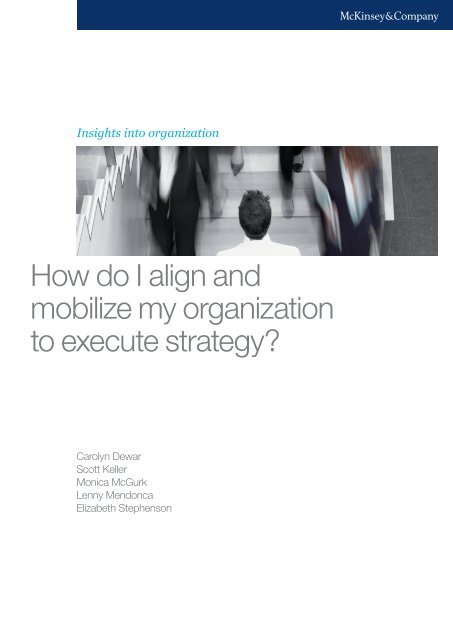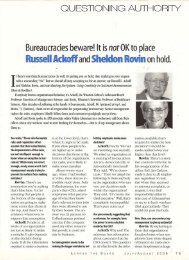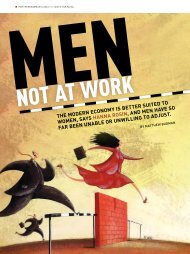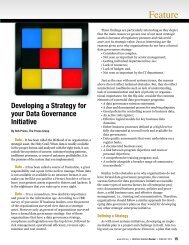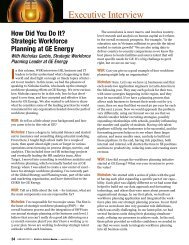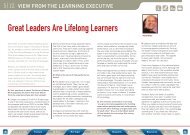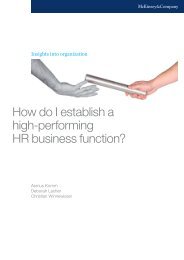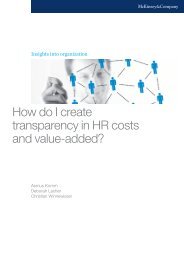How do I align and mobilize my organization to execute strategy?
How do I align and mobilize my organization to execute strategy?
How do I align and mobilize my organization to execute strategy?
Create successful ePaper yourself
Turn your PDF publications into a flip-book with our unique Google optimized e-Paper software.
2What <strong>do</strong> I need <strong>to</strong> know?Leaders seeking <strong>to</strong> <strong>align</strong> their <strong>organization</strong> with their strategic plan would <strong>do</strong> well <strong>to</strong>heed four key lessons: the right <strong>strategy</strong> is one that employees want <strong>to</strong> implement;<strong>align</strong>ment starts with vision <strong>and</strong> values, not <strong>strategy</strong> <strong>and</strong> budgets; business <strong>strategy</strong>is only as effective as its corresponding behavioral <strong>strategy</strong>; <strong>and</strong> <strong>align</strong>ment <strong>and</strong>mobilization happen more in the “ask” than in the “tell.”The right <strong>strategy</strong> is one that employees want <strong>to</strong> implementWhat is the “right” <strong>strategy</strong>? Is it the one that goes after the biggest marke<strong>to</strong>pportunities? That leverages or builds distinctive capabilities? That employees arepassionate about <strong>and</strong> actually want <strong>to</strong> implement? In fact, it is all of these things. Theright <strong>strategy</strong>, we believe, is the one at the intersection of opportunity, capability, <strong>and</strong>passion (Exhibit 1).Exhibit 1The right <strong>strategy</strong>: opportunities + capabilities + employee passion• Industry forces• Market growth• Profit-pool trends• Cus<strong>to</strong>mer insights• CompetitivepositioningMarke<strong>to</strong>pportunitiesWinning<strong>strategy</strong>Distinctivecapabilities• Privileged assets(br<strong>and</strong>s, networks, IP)• Special relationships(access-giving,complementary)• Competencies (e.g.,supply chain, M&A)Employeepassion• Employee surveys• One-on-one interviews• Focus groups• Online “jams”*Frequently overlooked,but a vital ingredientin strategicdecision making* Live whole-company intranet discussions
<strong>How</strong> <strong>do</strong> I <strong>align</strong> <strong>and</strong> <strong>mobilize</strong> <strong>my</strong> <strong>organization</strong> <strong>to</strong> <strong>execute</strong> <strong>strategy</strong>? 5Alignment <strong>and</strong> mobilization happens more in the “ask” than in the “tell”Let us assume that a company has armed itself with the right <strong>strategy</strong>, ensured it isgrounded in shared vision <strong>and</strong> values, <strong>and</strong> included behavioral as well as businessaspects. <strong>How</strong> <strong>do</strong>es it now communicate the <strong>strategy</strong> <strong>to</strong> the <strong>organization</strong> as a whole?Most CEOs follow st<strong>and</strong>ard procedures: cascading communications, holdingroadshows, giving interviews in the in-house magazine, developing intranet features,<strong>and</strong> so on. These are all important <strong>and</strong> powerful <strong>to</strong>ols – but they are up <strong>to</strong> five timesmore effective when oriented <strong>to</strong>wards “asking” rather than “telling.”Consider a famous experiment where researchers ran a lottery with a twist. Half theparticipants were given a lottery ticket with a ran<strong>do</strong>m number printed on it. The otherhalf were asked <strong>to</strong> choose their own number <strong>and</strong> write it on a blank ticket. Beforedrawing the winner, researchers offered <strong>to</strong> buy back the tickets. They wanted <strong>to</strong> fin<strong>do</strong>ut whether there would be any difference in the price dem<strong>and</strong>ed by the people whohad been h<strong>and</strong>ed a number <strong>and</strong> those who had chosen a number for themselves.Given that a lottery is pure chance, the rational answer would be that there should belittle or no difference. The real answer? Researchers had <strong>to</strong> pay at least five timesmore <strong>to</strong> those who wrote their own number. 6The lesson for business leaders is that if you can give employees a feeling of authorship,they will be far more committed <strong>to</strong> the outcome. This <strong>do</strong>es not mean that the <strong>strategy</strong>itself must be “authored” by a large group, but that each group <strong>and</strong> individual shouldhave a chance <strong>to</strong> “author” what it means for them. Why not have employees write<strong>do</strong>wn <strong>and</strong> share their impression of what the company <strong>strategy</strong> means for their area,as David Roberts did as CEO of Barclays Personal Financial Services? 7 Or ask your<strong>to</strong>p 300 <strong>to</strong> work <strong>to</strong>gether in a series of multi-day offsites <strong>to</strong> flesh out the operationaldetails of your <strong>strategy</strong>, as Neville Isdell did as CEO of Coca-Cola? 8 Or make a poin<strong>to</strong>f asking employees everywhere in the <strong>organization</strong> “<strong>How</strong> <strong>do</strong> you make a difference<strong>to</strong> our success?” as Dave Farr <strong>do</strong>es as CEO of Emerson Electric?6 See Ellen J. Langer, “The illusion of control,” in Daniel Kahneman, Paul Slovic, <strong>and</strong> Amos Tversky, eds.,Judgment under Uncertainty: Heuristics <strong>and</strong> biases, Cambridge University Press, 1982. This experiment hasbeen repeated in various countries <strong>and</strong> with various demographic groups with similar results, <strong>and</strong> the size ofthe prize appears <strong>to</strong> make no difference.7 David Roberts, “Easy <strong>to</strong> <strong>do</strong> business with: The way ahead for PFS,” Barclays Bank, April 2002.8 Adrienne Fox, “Refreshing a beverage company’s culture,” HR Magazine, November 1 2007.
6ContactsAmericasScott KellerPrincipalChicago office+ 1 (312) 795 7082scott_keller@mckinsey.comEurope, Middle East, <strong>and</strong> AfricaPierre GurdjianDirec<strong>to</strong>rBrussels office+32 (2) 6454340pierre_gurdjian@mckinsey.comAsia PacificGautam KumraDirec<strong>to</strong>rDelhi office+91 (124) 6611025gautam_kumra@mckinsey.com
Organization PracticeSeptember 2009Copyright © McKinsey & Company


